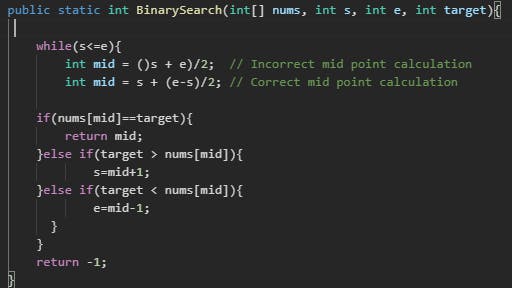Master Binary Search Challenges on LeetCode: My Experience
Introduction:
Binary search is a powerful algorithm used to efficiently search for an element in a sorted array. While it may seem straightforward at first glance, mastering binary search opens the door to solving a wide range of problems with elegance and efficiency. In this blog post, we'll explore the complexity of binary search and dive into some common problems where it shines. Armed with insights and experiences gained from tackling various challenges, We will uncover the art of binary search in solving complex problems.
Understanding Binary Search:
At its core, binary search works by repeatedly dividing the search interval in half until the desired element is found or the interval is empty. This divide-and-conquer approach allows binary search to achieve a time complexity of O(log n), making it significantly faster than linear search for large datasets.
Key Concepts:
Before we delve into binary search problems, let's review some key concepts:
Sorted Array: Binary search requires the input array to be sorted in ascending order.
Midpoint Calculation: The algorithm calculates the midpoint of the search interval to determine whether the target element lies to the left or right.
Updating Search Interval: Based on the comparison of the target element with the midpoint, the search interval is updated accordingly.
Mistakes to Avoid:
Forgetting to Sort the Array: Binary search requires the input array to be sorted in ascending order. Forgetting to sort the array before applying binary search can lead to incorrect results.
Incorrect Midpoint Calculation: Instead of calculating the midpoint as
(low + high) / 2, consider using(low + (high - low) / 2)to avoid integer overflow, especially when dealing with large arrays.Not Updating High/Low Correctly: Ensure that you update the
highandlowpointers correctly based on the comparison with the midpoint. Failing to update these pointers properly can result in an infinite loop or incorrect results.
By avoiding these common mistakes, you'll be able to tackle binary search problems efficiently and with confidence.

Exploring Problem Types:
1. Binary Search on 1-D Arrays:
- This classic problem type involves searching for a target element in a sorted array.
2. Binary Search on the Answer:
In these types of questions, we are tasked with finding a specific value by performing binary search on the possible range of answers.
Key considerations include knowing the range of possible answers and implementing techniques like lower bound, floor/ceil in sorted arrays, and handling scenarios like searching in rotated sorted arrays.
Examples include finding peak elements, square roots of numbers, and solving specific problems like "Koko Eating Bananas."
3. Binary Search on 2-D Arrays:
Expanding our horizon, binary search can also be applied to multidimensional arrays.
Challenges in this category may involve searching for a target element in a sorted 2-D array or tackling more intricate problems unique to 2-D arrays.
Conclusion:
As we conclude our expedition through the realm of binary search, remember that mastery comes not only from theoretical understanding but also from practical experience. Embrace the challenges, learn from your mistakes, and celebrate your victories along the way. With each problem solved, you inch closer to unlocking the full potential of binary search and becoming a proficient problem-solver in the ever-evolving world of algorithms.